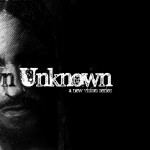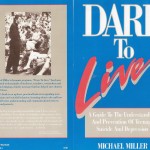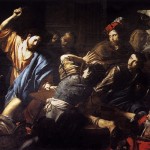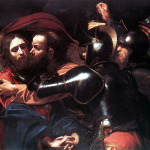What are we to make of Mark’s apparently unresolved ending? The earliest manuscripts we possess do not contain anything after 16:8. 16:9-20 appears to be one of at least two attempts to erase the uneasy feeling the ending at 16:8 leaves.
Here, the women encounter the angel at the empty tomb, are told of Jesus’ resurrection and instructed to tell the disciples that Jesus will meet them in Galilee. But instead of recounting this meeting, Mark 16:8 draws the narrative quickly to a close.
They went out and fled from the tomb, for trembling and astonishment had gripped them; and they said nothing to anyone, for they were afraid.
The end?
It’s easy to see why so many are reluctant to accept 16:8 as Mark’s intended ending. Why would the author choose to end his book with the disobedience of the women, leaving his audience aanticipating an appearance of the resurrected Jesus that, as far as the narrative is concerned, will never come?
But there’s good reason to beleve Mark intended to end his gospel at precisely this point. In highlighting a future meeting in Galilee, Mark has, of course, ignored the more imminent resurrection appearances in Jerusalem and Judea which we know from Luke and John. Galilee is a three day journey from Jerusalem. In predicting a future appearance in Galilee, Mark has in fact established that this predicted meeting will occur off-stage, in another time and place. The women receive the good news and rush off. The curtain closes. There is nothing unresolved. Due to Mark’s emphasis on fulfillment of Jesus’ predictions throughout the gospel, the meeting between Jesus and disciples is assured.
It’s not necessary for us to assume that Mark planned on recording this meeting. The desires of readers is not always in line with the plan of the author. Mark, of course, isn’t the only book in Scripture to end without gratifying readers curiosity. For instance, readers of Jonah never find out if Jonah repents and those who read Acts never find out if Paul wins his trial before Ceasar.
A decision on Mark’s part not to record a meeting with the risen Jesus is of course a much bigger issue. So why would Mark choose to end his Gospel without recording this all important meeting? The meeting would detract from the message he already convese in the ending he wrote. By not recording this resurrection appearance, Mark has placed greater weight on the details leading up to his ending. Among the details he focuses on are
In looking for the meaning in Mark’s abrupt ending, we find that these details speaking far more than what we might otherwise hear them say.
Before we discuss the significance of these details, however, its important to point out Mark’s special enigmatic quality. Its typical of Mark not to explain his meaning but instead to leave a trail of bread-crumbs for his readers to follow. Mark shows. He doesn’t usually tell. Here’s an example: Mark never identifies John the Baptist as Elijah. What Mark does is describe John as dressed in a leather belt (Mark 1:6), which if you know the OT will point you to Elijah (2 Kings 1:8). Mark also presents John’s death through the machinations of a royal couple who, if you know the OT, will seem surprisingly reminiscent of Elijah enemies, Ahab and Jezebel (Mark 6, 1 Kings). Mark even quotes from Malachi and alludes to the promise of Elijah’s coming at the end of that book (Mark 1:3, Mark 9:9-13). But not once does Mark explicitly say that John the Baptist was Elijah or an Elijah figure. That explicit connection is found only in the other gospels. Matthew, for instance, adapting Mark, makes this identification plain (Matthew 11:14). Mark, on the other hand, is not plain. He leaves his readers to follow a trail of clues to arrive at this conclusion. From this example and other like it, its clear that Mark expected a great deal of knowledge and sensitivity on the part of his readers.
Now let’s turn to the details mentioned above. Each of these concluding details is extremely significant and bears further reflection in light of Mark’s narrative. Let me start with the third point, the invitation to meet Jesus in Galilee, and work back towards the first.
The Invitation to Meet Jesus in Galilee
Though Jesus could have met the disciples in Jerusalem, as both Luke and John record, Mark points to an appearance of Jesus outside the environs of the empty tomb, Jerusalem and even Judea. Does that seem odd? It should. As we have already seen. It appears from a reading of Mark’s narrative that this is a riff on the command to follow. Its the promise of a restoration for the disciples after their failure to follow Jesus in the crucifixion.
The Gospel of Mark is divided into three sections: Jesus’ ministry in Galilee (Ch. 1-8): a central journey to Jerusalem (Ch. 8-10), and finally Jesus ministry in Jerusalem (11-16). The central motif of Mark’s gospel is a journey. Over and over again Mark stresses the disciples call to “follow” Jesus. Peter, Andrew, James, and John left their boats and nets (Mark 1). Levi left his tax collectors booth (Mark 2)
Mark certainly sets his readers up for not seeing the risen Jesus by the end of narrative. He does this by predicting a future meeting in Galilee. In promising this meeting, Mark bypasses any hint of a more imminent resurrection meetings in Jerusalem and Judea which we know of from Luke and John. Galilee is a three day journey from Jerusalem. In this prediction, Mark establishes the fact that Jesus will appear off-stage in another time and place. The women receive the good news and rush off stage. The curtain closes. There is nothing unresolved. Due to Mark’s emphasis on fulfillment of Jesus’ predictions throughout the gospel, the meeting between Jesus and disciples is assured.
So why would Mark choose to end his Gospel without recording such a meeting with the resurrected Christ. In not showing Jesus, Mark places greater weight on several details leading up to his ending. Among the details he focuses on are
In looking for the meaning in Mark’s abrupt ending, we find that these details speaking far more than what we might otherwise hear them say.
Before we discuss the significance of these details, however, its important to point out Mark’s special enigmatic quality. Its typical of Mark not to explain his meaning but instead leave a trail of bread-crumbs for his readers to follow. Mark shows. He doesn’t usually tell. Here’s an example: Mark never identifies John the Baptist as Elijah. What Mark does is describe John as dressed in a leather belt (Mark 1:6), which if you know the OT will point you to Elijah (2 Kings 1:8). Mark also presents John’s death through the machinations of a royal couple who, if you know the OT, will seem surprisingly reminiscent of Elijah enemies, Ahab and Jezebel (Mark 6, 1 Kings). Mark even quotes from Malachi and alludes to the promise of Elijah’s coming at the end of that book (Mark 1:3, Mark 9:9-13). But not once does Mark explicitly say that John the Baptist was Elijah or an Elijah figure. That explicit connection is found only in the other gospels. Matthew, for instance, adapting Mark, makes this identification plain (Matthew 11:14). Mark, on the other hand, is not plain. He leaves his readers to follow a trail of clues to arrive at this conclusion. From this example and other like it, its clear that Mark expected a great deal of knowledge and sensitivity on the part of his readers.
Now let’s turn to the details mentioned above. Each of these concluding details is extremely significant and bears further reflection in light of Mark’s narrative. Let me start with the third point, the invitation to meet Jesus in Galilee, and work back towards the first.
The Invitation to Meet Jesus in Galilee
Though Jesus could have met the disciples in Jerusalem, as both Luke and John record, Mark points to an appearance of Jesus outside the environs of the empty tomb, Jerusalem and even Judea. Does that seem odd? It should. As we have already seen. It appears from a reading of Mark’s narrative that this is a riff on the command to follow. Its the promise of a restoration for the disciples after their failure to follow Jesus in the crucifixion.
The Gospel of Mark is divided into three sections: Jesus’ ministry in Galilee (Ch. 1-8): a central journey to Jerusalem (Ch. 8-10), and finally Jesus ministry in Jerusalem (11-16). The central motif of Mark’s gospel is a journey. Over and over again Mark stresses the disciples call to “follow” Jesus. Peter, Andrew, James, and John left their boats and nets (Mark 1). Levi left his tax collectors booth (Mark 2)
In the central journey (8-10), Mark hammers home what Jesus means by his call to follow. Jesus says in 8:34-35,
Whoever wants to be my disciple must deny themselves and take up their cross and follow me. For whoever wants to save their life will lose it, but whoever loses their life for me and for the gospel will save it.
Jesus call to follow is a call to come and die with Him. The disciples, however, in Mark fail again to again to understand this crucial point. Peter does, however, remind Jesus that, “We have left everything to follow you!” (Mark 10:28)
But in the end the disciples do not follow Jesus in his death. They abandon their call and run away. The invitation to meet Jesus in Galilee at the end of Mark’s gospel is once again Jesus call to follow. And not surprisingly its a call to meet Jesus at the very place where they were first called: Galilee. The reason Mark does not show his readers a meeting with the risen Jesus is that the invitation is left open for them. The abrupt ending leaves the invitation ringing in the readers ears. The question Mark leaves his readers with is “will you follow? Will you see Jesus? Even if it means going to your death?”
The Young Man Dressed in White.
The appearance of the young man is another indicator that Mark’s ending is about the restoration of the disciples. Surprisingly, Mark never calls this person an angel. This is important. The only other time we read about a “young man” in Mark’s gospel is the “young man” who flees naked from Gethsemane. Mark has established a literary connection between these two figures. The connection suggests that together they are representative figures of the disciples. For instance the “young man” mentioned in Mark 14 appears immediately after the disciples run away. Like the disciples he is following Jesus and has left everything to follow Him. Mark notes that he’s wearing only a linen sheet. That a linen sheet only appears elsewhere wrapped around the dead body of Jesus (Mark 15) also suggests this “young man” has left everything to embrace the call to come and die with Jesus. But when that opportunity finally comes, he like the disciples abandons his call, and runs away naked, a clear scriptural reference to shame.
All these details makes it all the more significant that the “young man” who appears to the women at the tomb is also described by what he’s wearing. He’s dressed in a white robe. Elsewhere in scripture we find that a white robe is a symbol for the saints and their purity. Again, all this suggests that Mark records and describes these two “young men” as symbols of the disciples abandonment and restoration. I am not saying that these two men are not historical figures or that the young man at the tomb is not an angel. I’m saying that Mark is using this historical material and presenting in such a way that we see this deeper meaning.
The Rolled Stone
Given the fact that Mark does not record an eyewitness meeting with the risen Jesus, its interesting that Mark spends much of his ending returning to the movement of the stone – three times in fact. In 15:46, Mark informs reader that Jesus’ tomb “had been cut out of the rock” and it was sealed by rolling a stone against the entrance. And when the women arrive in 16:3, three verses later, they wonder, “who will roll away the stone?” The answer comes in the following verse when they discover the “stone had been rolled back.” Mark further adds “that it was very large.” Why such stress on this detail?
Interestingly, the only other place in Mark we read about stones is in the section dealing with Jesus’ judgment of Jerusalem and the temple (Mark 11-13). There we find two scenes referring to stones. The first occurs at the end of Jesus’ parable of the tenants and deals with the reversal of fortune for the rejected stone (jesus and or the “others”) in the coming destruction of the temple. The next appears less than a chapter later at the introduction of the Olivet Discourse. The disciples admiration for the stones of the temple, prompts Jesus to remark that they will all be thrown down. Again the readers are pointed to a reversal of fortune for stones brought about by the coming destruction of the temple. For these two references, at least, stones are clearly connected with Jerusalem’s destruction.
Is it possible then that the rolled stone from the tomb’s entrance points to the same meaning? In the Olivet Discourse, Jesus explicitly connects the coming destruction of Jerusalem and the temple with the coming of the Son of Man, which is a clear reference to Daniel 7. In Daniel, that event brings about an end to the four beastly kingdoms and the establishment of a kingdom without end, represented in the coming of the Son of Man. But readers familiar with Daniel should in this reference also recall Daniel 2 and its related prediction. There, we find an idol/image with four different metals, also representing four kingdoms, which are likewise destroyed and supplanted by an everlasting kingdom. Instead of the Son of Man, however, the image in Daniel 2 is destroyed by a stone cut out from the mountain without human hands.
Daniel 2’s description of the stone matches in several ways Mark’s depiction of the tomb and its entrance. Daniel says it was a stone cut out from a mountain (Daniel 2:34, 45) while Mark tells his reader of the apparently otherwise-needless detail that the tomb had been cut out of the rock (Mark 15:46). Daniel also points to the divine origin of the stone which was “cut out by no human hands” just as Mark seems to point to some invisible hand which has rolled the “large” stone. All this appears to suggest that the destruction of the temple and the establishment of Jesus’ eternal kingdom are assured in Jesus’ resurrection.
In these three details, Mark has left his readers enough clues to piece together a coherent resolution.
By placing an eyewitness meeting with the risen Jesus outside the environs of the Judea, Jerusalem and the tomb, Mark calls the disciples and his readers to once again follow Jesus into the unknown.
By describing the angel as a “young man,” Mark symbolizes the disciples restoration though a literary restoration of the “young man” who represented the abandonment of the disciples in the garden.
And by emphasizing the movement of the resurrection stone, Mark points to the coming of the Son of man and the assured destruction of the temple and idolatrous kingdoms of this earth.
For those of you who are reluctant to accept such a “symbolic” reading, I must once again point out that this reading is not to say that these events are not historical. Mark clearly presents these events as occurring in real time and space. But Mark’s narrative is more than history. As with the leather belt wrapped around John the Baptist, Mark draws his readers in by presenting details which he expects his readers to decipher. Like Jesus’ parable of the sower (what is in fact Jesus’ parable of the parables), Mark’s gospel is also seed looking for the right soil.















